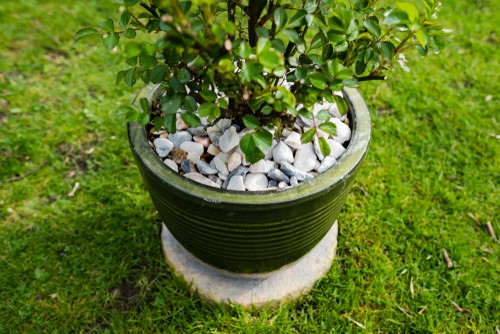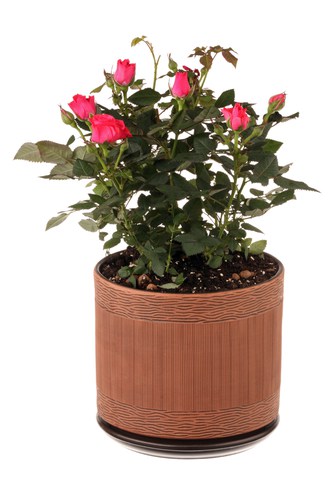Last updated on March 31st, 2022
Our site is reader supported, this means we may earn a small commission from Amazon and other affiliates when you buy through links on our site.
There are many, many rose varieties available for you to choose from, roses for every occasion and location whether it’s a small patio rose or a David Austin shrub rose. Some roses perform better in pots and containers than others so, no matter how small your garden might be, you can find a variety to fit your space perfectly.
Out of all the varieties of roses, you can find, rambling roses do not thrive in pots. They grow much more vigorously in comparison to other roses and they need significantly larger spaces to sustain their growth. However, if you are looking for a climbing-type rose then there are plenty of miniatures climbers available, and even most climbers will grow happily in a large pot too.
Aside from ramblers, all other varieties respond well to deadheading too and this will prolong the flowering periods. As a rule of thumb, if you are thinking of growing roses in containers, we recommend looking for patio varieties. These generally have much smaller flowers, and patio climbers tend to be less vigorous than normal climbers. Then, of course, there are the hybrid tea roses, floribundas, and shrub / Old English roses, all of which will grow well in a good-sized container.
Choosing the right size pot or container
The container size should be at a minimum of 30cm by 30cm (1ft x 1ft) for anything that climbs, even if it is a miniature variety. If you have roses that spread and function as cover in the container, something that is 45cm by 45cm is better. This will vary, of course, based on the variety you choose and the size requirements for said variety. You then, of course, want to move up into larger pots over the coming years into the largest pot you are comfortable with.

In terms of material, you can get away with just about anything. Plastic is the most lightweight material, so if you plan on moving your roses around the garden, the lightweight material might come in useful. However, many people prefer wooden or ceramic planters because these offer better aesthetics, but also contribute to a heavier weight when you are moving them around.
If you have a more permanent position in your garden where you want the rose bush to go, a more substantial container won’t matter as much. It’s worth noting that glazed pots are also much better suited because they are generally frost resistant and will not crack.
Recommended Roses for Pots
There are a few recommended varieties for pots. Miniature types are best because they are specifically bred for compact growth and shallow root structures.

Some of the best varieties include:
- ‘Queen Mother’
- ‘Flower Power’
- ‘Anna Ford’
- ‘Sweet Dream’
- ‘Wild Fire’
- ‘Peter Pan’
- ‘Nice Day’
- ‘Bianco’
- ‘Bright Smile’
- ‘Stamford’s Sanctuary’
- ‘Open Arms’
- ‘Kew Gardens’
- Lightly scented vibrant flowers
- Ideal on patios or borders
- Make excellent indoor plants
- Easy to care for
- Supplied in 10.5cm growers ppot
- ROSE BUSH TRIO - Our rose bush trio is a lovely mix of three separate rose bushes planted into the one 3 litre pot. This rose trio is ideal for growing in borders or patio pots or containers to add impact to any garden.
- MIXED COLOURS - This trio will produce a wonderful mix of colours and a mass of flowers throughout the Summer and early Autumn. Our rose bush trio is created from a variety of bare roots and each pot will vary colour wise. Colours of roses used include red, white, yellow, pale pink, hot pink and orange.
- GROWING CONDITIONS - Roses thrive in sunny locations, needing at least six hours of direct sunlight daily, planted in well draining nutrient rich soil. Roses require consistent watering, especially during dry periods but avoid overwatering.
- PLEASE NOTE - At certain times of the year, your rose trio may arrive looking, like photo four in our listing. All of our roses are now pruned back to help make them a much bushier specimen in the coming years. These are cut back SEPTEMBER - APRIL.
- Lightly scented vibrant flowers
- Ideal on patios or borders
- Make excellent indoor plants
- Easy to care for
- Supplied in 10.5cm growers ppot
- Celebration Rose
- Clusters of double blooms which are soft lemon to cream
- The foliage is glossy and has a compact bushy growth and good hardiness
- Repeat Flowering adding a pop of colour all summer long
- UK rose growers with over 20 years experience supplying 1st grade roses directly from our fields
- Award-Winning Floribunda Rose – Rosa 'Margaret Merril' is a gold medal winner, celebrated for its stunning whiAward-Winning Floribunda Rose – Rosa 'Margaret Merril' is a gold medal winner, celebrated for its stunning white blooms and subtle fragrance, making it a must-have for rose enthusiasts and gardeners alike.te blooms and subtle fragrance, making it a must-have for rose enthusiasts and gardeners alike.
- Perfect for Small Gardens & Containers Ideal for patio gardens, balconies, and containers, this variety has a compact growth habit, reaching just 50 - 60cm (20 - 24 inches) tall and wide. Its small size makes it an excellent choice for city gardens or those with limited space
- Long - Lasting, Beautiful Blooms Enjoy abundant, peachy - apricot flowers from early summer to autumn. Rosa Sweet Dreams offers a continuous display of soft, fragrant blooms that are perfect for brightening your gard en, while also attracting beneficial pollinators like bees and butterflies.
- Strong Disease Resistance & Easy Care This rose is highly resistant to common rose diseases, such as black spot and powdery mildew, making it a low - maintenance choice for gardene rs. Its resilience and robust growth make it an ideal rose for both novice and experienced gardeners
- Bare Root for Easy Planting Delivered as a bare root rose, Rosa Sweet Dreams is easy to plant and establish. Simply soak the roots before planting, and enjoy years of vibrant blooms. It thrives in full sun and well - drained soil, with a recommended planting time of late autumn or early spring
What to consider when you are planting your patio roses
Compost
When planting, we recommend using loam-based compost. You can add well-rotted manure to the compost for richness, but be sure to mix it thoroughly with the soil. We recommend using John Innes Potting compost, although, should you prefer, you can also buy specialist rose and shrub compost. Don’t forget to add some crockery to the bottom of the pot to prevent the holes from getting clogged up.
- perfect for the final potting of plants into pots or outdoor containers.
- provides a long-term home with good drainage and stability.
Where to position your container-grown roses
Be sure to position your container where you want it to reside before you fill it and add the rose bush because the pot will be much heavier once it completely filled with all the soil.
The position you choose needs to be one that receives ample sunlight, and in general, the more the better, roses need sunshine for at least half of the day.
Watering
That being said, container-grown plants are prone to powdery mildew if they become waterlogged. Conversely, they also dry out faster, so you should keep tabs on the watering schedule you keep and the moisture level of the soil. If at all possible, find an area where the physical pot and roots can be kept in the shade for part of the day, but the majority of the plant can be in the sun most of the day.
Bare root vs Potted roses
Roses purchased between November and April often come in the form of a bare root plant, so you won’t have to worry about removing them from a pot. They are often a little cheaper too so it’s worth considering bare root plants if you can, however, they can only be purchased when roses are dormant for the winter. Fill the pot two-thirds of the way, add the rose, and then backfill it the rest of the way, only planting to the depth it was previously, which you can usually tell by looking at the rose carefully.
If you purchased your rose between May and November, your rose bush will come in a container and may even be in flower, if not yet in flower it will certainly have fresh foliage on it. Carefully hold it horizontally, and wiggle it loose from the base until it comes free from the pot. Then gently tease the roots if they are compact and place them in the new container at the same depth it was in the original container.
General Rose Care
Drainage
Drainage is essential, so you can help the pot drain well with an extra layer of gravel at the bottom of the pot. You can also keep the pot raised on some feet so that the water can drain freely from the bottom, it’s also much less likely that the holes will become blocked.

Mulch
Mulching will go a long way towards retention. You can add 5cm of mulch in the form of compost or well-rotted manure right after planting the rose bush. This will help keep moisture in the soil (which is even more essential for those in pots) and enrich the compost at the same time. This is something not everybody does because it can be a little more difficult to keep an eye on whether the soil has become dry.
Feeding patio roses
In terms of food, rose bushes use their food reserves quickly, so they do better if you add rose fertiliser every spring. The only time you should avoid feeding is after August when the soft growth risks damage by cold weather and frost.
Pruning patio roses
Pruning is best done on an as-needed basis, annually, after the flowering has ended. You should start by pruning any dead or diseased branches, and then any rubbing or crossing branches. We also recommend hard pruning roses in early spring and cut back to as low as 30cm because this encourages a bushier rose and keeps it looking lush from the base, stops them from getting too tall, and promotes better flowering.
Repotting roses
Every three or four years, the rose bushes should be repotted in a slightly larger container. Use fresh soil-based compost when doing so. In all other years, you can do a top dressing by removing the top 5cm of compost and replace it with fresh compost, and giving it a base feed in spring. This will help replenish lost nutrients.
Deadheading
One big part of regular maintenance is that of deadheading. By removing the dead flowers as they finish, you can encourage more flowers to bloom throughout the season. Many roses will even flower into November.
Pests and Diseases

Roses, even container-grown roses, are susceptible to a variety of pests and diseases but aphids and black spot are the most common problems. You can prevent most of them by carefully watering, never overwatering or underwatering, and keeping your eyes peeled for any signs of pests on the plants.
Insecticides and fungicides go a long way for the immediate treatment of any pests or diseases that crop up. We recommend spraying with a fungicide as soon the leaves shoot in spring to try and help prevent diseases like black spot, mildew and rust before they start. Prevention is much better than trying to deal with the problem afterward. You can buy 3 in 1 spray for roses which will kill aphids but also help prevent and control diseases.
- Systemic insecticide and fungicide with 3-in-1 action
- Kills systemically and on contact
- Kills aphids
- Controls blackspot, powdery mildew and rust
- Protects for up to 21 days to prevent further attacks
- Systmic insecticide and fungicide with 3-in-1 action
- Kills systemically and on contact
- Kills aphids
- Controls blackspot, powdery mildew and rust
- Protects for up to four weeks to prevent further attacks
By following these rules, keeping the right sized pot, and growing the right variety, you can keep roses blooming year after year, no matter how small your space might be.
Last update on 2025-12-13 / Affiliate links / Images from Amazon Product Advertising API










